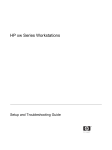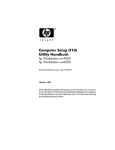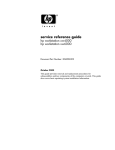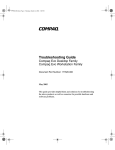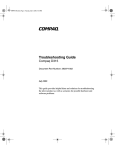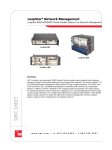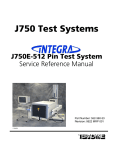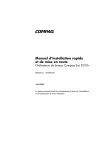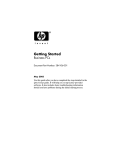Download HP XW6000 PC Desktop
Transcript
301198-001.book Page i Thursday, July 18, 2002 8:12 PM getting started hp workstation xw4000 hp workstation xw6000 Document Part Number: 301198-001 October 2002 This book will help you set up factory-provided software. Basic troubleshooting is also provided should you have problems during initial startup. 301198-001.book Page ii Thursday, July 18, 2002 8:12 PM © 2002 Hewlett-Packard Company Compaq and the Compaq logo are trademarks of Compaq Information Technologies Group, L.P. in the U.S. and/or other countries. Microsoft, MS-DOS, Windows, and Windows NT are trademarks of Microsoft Corporation in the U.S. and/or other countries. Adobe, Acrobat, and Acrobat Reader are trademarks or registered trademarks of Adobe Systems Incorporated. All other product names mentioned herein may be trademarks of their respective companies. Hewlett-Packard Company shall not be liable for technical or editorial errors or omissions contained herein or for incidental or consequential damages in connection with the furnishing, performance, or use of this material. The information in this document is provided “as is” without warranty of any kind, including, but not limited to, the implied warranties of merchantability and fitness for a particular purpose, and is subject to change without notice. The warranties for HP products are set forth in the express limited warranty statements accompanying such products. Nothing herein should be construed as constituting an additional warranty. This document contains proprietary information that is protected by copyright. No part of this document may be photocopied, reproduced, or translated to another language without the prior written consent of Hewlett-Packard Company. Å WARNING: Text set off in this manner indicates that failure to follow directions could result in bodily harm or loss of life. Ä CAUTION: Text set off in this manner indicates that failure to follow directions could result in damage to equipment or loss of information. getting started hp workstation xw4000 hp workstation xw6000 First Edition (October 2002) Document Part Number: 301198-001 301198-001.book Page iii Thursday, July 18, 2002 8:12 PM Contents 1 Software Setup Installing the Operating System . . . . . . . . . . . . . . . . . . . . . . . . . . . . . . . . . . . . . . . . . . File System Format . . . . . . . . . . . . . . . . . . . . . . . . . . . . . . . . . . . . . . . . . . . . . . . . . . . . Converting to NTFS . . . . . . . . . . . . . . . . . . . . . . . . . . . . . . . . . . . . . . . . . . . . . . . . Transaction Logs . . . . . . . . . . . . . . . . . . . . . . . . . . . . . . . . . . . . . . . . . . . . . . . Access Control . . . . . . . . . . . . . . . . . . . . . . . . . . . . . . . . . . . . . . . . . . . . . . . . . NTFS Convert Desktop Icon . . . . . . . . . . . . . . . . . . . . . . . . . . . . . . . . . . . . . . . . . Installing or Upgrading Device Drivers . . . . . . . . . . . . . . . . . . . . . . . . . . . . . . . . . . . . Customizing the Monitor Display . . . . . . . . . . . . . . . . . . . . . . . . . . . . . . . . . . . . . . . . . Turning Off Your Computer . . . . . . . . . . . . . . . . . . . . . . . . . . . . . . . . . . . . . . . . . . . . . Protecting Your Software . . . . . . . . . . . . . . . . . . . . . . . . . . . . . . . . . . . . . . . . . . . . . . . Restoring Your Software. . . . . . . . . . . . . . . . . . . . . . . . . . . . . . . . . . . . . . . . . . . . . . . . Using the Documentation Library CD . . . . . . . . . . . . . . . . . . . . . . . . . . . . . . . . . . . . . Regulatory Information . . . . . . . . . . . . . . . . . . . . . . . . . . . . . . . . . . . . . . . . . . . . . . . . . Getting Help . . . . . . . . . . . . . . . . . . . . . . . . . . . . . . . . . . . . . . . . . . . . . . . . . . . . . . . . . 1–1 1–2 1–2 1–2 1–2 1–3 1–3 1–4 1–4 1–5 1–5 1–5 1–6 1–6 2 Basic Troubleshooting Overview . . . . . . . . . . . . . . . . . . . . . . . . . . . . . . . . . . . . . . . . . . . . . . . . . . . . . . . . . . . . Helpful Hints . . . . . . . . . . . . . . . . . . . . . . . . . . . . . . . . . . . . . . . . . . . . . . . . . . . . . . . . . Solving General Problems. . . . . . . . . . . . . . . . . . . . . . . . . . . . . . . . . . . . . . . . . . . . . . . Solving Hardware Installation Problems. . . . . . . . . . . . . . . . . . . . . . . . . . . . . . . . . . . . Diagnostic Keyboard LEDs, Front Panel LEDs, and Audible Codes . . . . . . . . . . . . . . 2–1 2–1 2–3 2–8 2–9 Index Getting Started iii 301198-001.book Page 1 Thursday, July 18, 2002 8:12 PM 1 Software Setup Installing the Operating System Ä CAUTION: Do not add optional hardware devices or third-party devices to your computer until the operating system is successfully installed. Doing so may cause errors and may prevent the operating system from installing properly. The first time you turn on your computer, you may be prompted to select a language for your operating system (OS) and then you will be asked to install your OS. You must install the OS completely. Read and follow the instructions on the screen to complete the installation of the OS. If electing to use an OS different than what was shipped with your system, refer to the following support Web site location for additional support that may be available: http://www.compaq.com/support/workstations/index.html Ä CAUTION: During the OS installation process, do not turn off your computer unless you are directed to do so. HP is committed to designing products, services, and programs with improved usability and accessibility for all customers. HP products with Microsoft Windows XP preinstalled, or that are XP Ready, are designed for accessibility. These products are tested with industry-leading Assistive Technology products to ensure equal access—anytime, anywhere... to anyone. Getting Started 1–1 301198-001.book Page 2 Thursday, July 18, 2002 8:12 PM Software Setup File System Format on your system, you may be prompted to select a file ✎ Depending system format during the initial setup of your system. Hard drives can be configured in three basic formats: FAT16 and FAT32 (for HDD partitions less than 8 GB), or NTFS (for HDD partitions up to and greater than 8 GB), with variances of each, depending on the operating system and hard drive support. To check the file system format assigned to your hard drive (factory settings), open My Computer, right-click on Local Disk (C:), then select Properties. ✎ Microsoft Windows 98 supports the FAT32 file system format only. Converting to NTFS NTFS offers the following features: ■ Transaction logs ■ Access control Transaction Logs Transaction logs help recover from disk failures. Access Control Access Control allows you to set permissions to control access to your files and directories. Depending on which file system format your hard drive is using, the NTFS Convert utility may be available for you to convert part or all of the drive partition to NTFS format. Ä 1–2 CAUTION: You may experience data loss if you attempt to convert your drive to NTFS using the methods described in this section. Before converting your drive, make a backup copy of all data stored on your hard drive. Getting Started 301198-001.book Page 3 Thursday, July 18, 2002 8:12 PM Software Setup NTFS Convert Desktop Icon Double-click the NTFS Convert icon located on the desktop. Read and follow the instructions that appear on the screen to change the drive partitioning. This feature is available on select models only. Installing or Upgrading Device Drivers To install optional hardware devices after the OS installation is complete, you must install the device drivers for the devices you are installing. If prompted for the I386 directory, replace the path specification with C:\I386, or use the Browse button of the dialog box to locate the I386 folder. This action points the OS to the appropriate drivers. can obtain the latest support software, including support software ✎ You for your OS from: http://www.compaq.com/support You can also obtain the latest support software through a subscription to the Compaq Support CD Kit using the Support Software Management order form available at the following Web site: http://www.compaq.com/support/files/workstations/us/ purchase.html This site also provides information on how to purchase a subscription. your system has an optical RW drive, you must install the ✎ Ifappropriate application to be able to write to the drive. To install the drivers, double-click the Setup Software icon on the desktop or the application launcher and select the Easy CD Creator and Direct CD option when prompted. Getting Started 1–3 301198-001.book Page 4 Thursday, July 18, 2002 8:12 PM Software Setup Customizing the Monitor Display To change the default configuration settings for your monitor display, such as the screen resolution, color settings, and font sizes, double-click the Display icon in the Control Panel. For more information about your display driver and other utilities that you can use with your graphics controller, refer to your graphics controller documentation. can obtain the latest graphics drivers from ✎ You http://www.compaq.com/support. Turning Off Your Computer To properly turn off your computer, click Shut Down on the Start menu. In Windows XP, select Turn Off Computer on the Start menu. The computer will automatically shut down. In Windows NT Workstation 4.0, the power button always functions as a power switch. However, in the default configuration of Windows 98, Windows 2000 Professional, Windows XP Professional or Windows XP Home, pressing the power button does not turn off the power, but causes the computer to enter a low-power state. This default configuration allows you to quickly power down, without closing applications, and to quickly return to the same operational state without any data loss. manually force the computer into an OFF state, press and hold the ✎ Topower button for four seconds. Ä CAUTION: Manually forcing the computer off can cause loss of data. reconfigure the power button to work in On/Off mode for ✎ ToWindows 98, Windows 2000 Professional, Windows XP Professional, or Windows XP Home, refer to the Desktop Management Guide for detailed instructions. 1–4 Getting Started 301198-001.book Page 5 Thursday, July 18, 2002 8:12 PM Software Setup Protecting Your Software To protect your software from loss or damage, keep a backup copy of all system software, applications, and related files stored on your hard drive. Refer to your OS or backup utility documentation for instructions on making backup copies of your data files. Restoring Your Software Restore the original operating system and factory-installed software by using the Compaq Restore CD or Restore Plus! CD, and any other CDs that came with the computer. Carefully read and follow the instructions for the restore solution that came with the computer. For questions about or problems with this CD, please contact customer service. Using the Documentation Library CD Refer to the Documentation Library CD for additional product documentation. you do not have a CD-ROM drive, you may download the product ✎ Ifdocumentation from http://www.compaq.com/support. 1. Insert the compact disc into the CD-ROM drive. There may be a slight delay while the software checks the Windows Regional Settings. If a recent version of Adobe Acrobat or Acrobat Reader is not found on the computer, it will be installed automatically from the CD. Read and follow the prompts to complete the installation. The menu and books are displayed in the language chosen during initial system setup or specified later in your Windows Regional Settings. If the Regional Settings do not match one of the languages supported on the CD, the menu and books are displayed in English. 2. Click the title of the book you want to read. Getting Started 1–5 301198-001.book Page 6 Thursday, July 18, 2002 8:12 PM Software Setup If there is no CD-ROM drive activity for two minutes or more, it may be because Autorun is not enabled on the system. To run the Documentation Library CD if it does not run automatically: 1. Click Start > Run. 2. Type: X:\DocLib.exe (where X is the drive letter designator for the CD-ROM drive) 3. Click OK. Regulatory Information These are Class B digital devices, pursuant to Part 15 of the FCC Rules. Refer to the Safety & Regulatory Information guide on the Documentation Library CD for Class B information. Getting Help Additional help and other information can be obtained through Technical Support information at http://www.compaq.com or in the warranty information included with your computer. 1–6 Getting Started 301198-001.book Page 1 Thursday, July 18, 2002 8:12 PM 2 Basic Troubleshooting Overview This chapter is intended for basic troubleshooting only. A comprehensive Troubleshooting Guide is available on the Documentation Library CD and at http://www.compaq.com/support. You may elect to purchase the Quick Troubleshooting Guide (part number 120205-002) that contains easy to follow flow charts that can lead you through the debug process. This guide was written for authorized service providers and contains steps that may be beyond the technical capabilities of some users. Improperly performing some processes identified in the guide may damage the computer and/or void your warranty. If you are unsure of your ability to perform the task, or if you are concerned about voiding your product warranty, contact you local authorized sales or service representative before undertaking the recommended corrective action. If electing to use an OS different than what was shipped with your system, refer to http://www.compaq.com/support/workstations/index.html for additional support that may be available. See “Restoring Your Software” in Chapter 1 for information regarding software problems. Helpful Hints If you encounter some minor problem with your computer, monitor, or software, refer to the following list of general suggestions before taking further action: ■ Getting Started Check that the computer and monitor are plugged into a working electrical outlet. 2–1 301198-001.book Page 2 Thursday, July 18, 2002 8:12 PM Basic Troubleshooting Ä 2–2 ■ Check to see that the computer is turned on and the green power light is on. ■ Check to see that the monitor is turned on and the green monitor light is on. ■ Turn up the brightness and contrast controls of the monitor if the monitor is dim. ■ Press and hold any key. If the system beeps, then your keyboard is operating correctly. ■ Check all cable connections for loose connections or incorrect connections. ■ Reconfigure your computer after installing a non–plug and play expansion board or other option. See “Solving Hardware Installation Problems” for instructions. ■ Be sure that all the needed device drivers have been installed. For example, if you have connected a printer, you need to install a printer driver. ■ Remove all diskettes from your system before turning it on. ■ If you have installed an operating system other than the factory-installed operating system, check to be sure that it is supported on your system. ■ If your system has multiple video sources (embedded, PCI, or AGP adapters) installed (embedded video on select models only) and a single monitor, the monitor must be plugged into the monitor connector on the source selected as the primary VGA adapter. During boot, the other monitor connectors are disabled and if the monitor is connected into these ports, the monitor will not function. You can select which source will be the default VGA source in Computer (F10) Setup. CAUTION: When the computer is plugged into an AC power source, there is always voltage applied to the system board. You must disconnect the power cord from the power source before opening the computer to prevent system board or component damage. Getting Started 301198-001.book Page 3 Thursday, July 18, 2002 8:12 PM Basic Troubleshooting Solving General Problems You may be able to easily resolve the minor problems described in this section. If a problem persists and you are unable to resolve it yourself or if you feel uncomfortable about performing the operation, contact an authorized dealer or reseller. Solving General Problems Problem Cause Solution Computer will not turn on. Computer is not connected to an external power source. Connect to an external power source. Cables to the external power source are unplugged. Ensure that cables connecting the computer to the external power source are plugged in properly and the wall outlet is active. A defective PCI card has been installed. Remove any expansion board that was just installed. Drive power, data, or power supply cables may not be properly connected. Reseat drive power, data, and power supply cables. The unit temperature was exceeded. The fan may be blocked. 1. Unit is in an exceedingly hot environment. Let it cool down. 2. Ensure that computer air vents are not blocked and internal fan is running. Contact an authorized reseller or service provider. Power line selector switch on rear of computer chassis is not switched to correct line voltage (115V or 230V) (some models). Getting Started Select the proper AC voltage using the slide switch. 2–3 301198-001.book Page 4 Thursday, July 18, 2002 8:12 PM Basic Troubleshooting Solving General Problems (Continued) Problem Cause Solution Computer appears locked up and will not turn off when the power button is pressed. Software control of the power switch is not functional. Press and hold the power button for at least four seconds until the computer turns off. Computer will not respond to USB keyboard or mouse. Computer is in Stand By mode. Press the power button to resume from Stand By mode. When attempting to resume from Stand By mode, Ä CAUTION: do not hold down the power button for more than four seconds. Otherwise, Stand By mode is lost, and you will lose your data. Computer powered off automatically and the Power LED is: 1. Flashing Red or Yellow four times per second, OR The unit temperature was exceeded. The fan may be blocked or not turning, OR the heatsink is not properly attached to the processor. 2. Flashing Red or Yellow two times one second apart, followed by a two second pause, OR 2. Ensure that computer air vents are not blocked and internal fans are running (i.e. power supply fan, chassis fan, and/or processor fan). 3. Ensure that the heatsink is properly seated. 4. Contact an authorized reseller or service provider. 3. Not flashing. The unit temperature was exceeded because the computer was functioning with the cover or access panel removed. 2–4 1. Unit is in an exceedingly hot environment. Let it cool down. Replace cover or access panel, and let the computer cool down before attempting to turn on power to the computer. Getting Started 301198-001.book Page 5 Thursday, July 18, 2002 8:12 PM Basic Troubleshooting Solving General Problems (Continued) Problem Cause Solution Computer date and time display is incorrect. RTC (real-time clock) battery may need to be replaced. Battery life is approximately 3–5 years. First, reset the date and time under Control Panel (Computer Setup can also be used to update the RTC date and time). If the problem persists, replace the RTC battery. Refer to the Hardware Reference Guide for instructions on installing a new battery, or contact an authorized dealer or reseller for RTC battery replacement. Computer appears to pause periodically. Network driver is loaded and no network connection is established. Establish a network connection, or use Computer Setup or Windows Device Manager to disable the network controller. Cannot remove computer cover or access panel. Smart Cover Lock, featured on some computers, is locked. Unlock the Smart Cover Lock using Computer Setup (F10 Setup). Poor performance is experienced. Processor is hot. The Smart Cover FailSafe Key, a device for manually disabling the Smart Cover Lock, is available from HP. You will need the FailSafe Key in case of a forgotten password, power loss, or computer malfunction. 1. Make sure the airflow to the computer is not blocked. 2. Make sure the fans are connected and working properly (some fans only operate when needed). 3. Make sure the processor heatsink is installed properly. Cursor will not move using the arrow keys on the keypad. Getting Started The Num Lock key may be on. Press the Num Lock key. The Num Lock light should not be on if you want to use the arrow keys. 2–5 301198-001.book Page 6 Thursday, July 18, 2002 8:12 PM Basic Troubleshooting Solving General Problems (Continued) Problem Cause Solution Blank monitor screen. Monitor is not turned on and the monitor light is not on. Turn on the monitor and check that the monitor light is on. The cable connections are not correct. Check the monitor cable connection from the monitor to the computer to the appropriate connector, and to the electrical outlet. If you have an AGP card installed, ensure that the monitor is connected to the AGP card. Computer is in Stand By mode. Press the power button to resume from Stand By mode. When attempting to resume from Stand By mode, Ä CAUTION: do not hold down the power button for more than four seconds. Otherwise, Stand By mode is lost, and you will lose your data. 2–6 System ROM is bad; system is running in Failsafe Boot Block mode (indicated by one long beep and three short beeps). Reflash the ROM using a ROMPaq diskette. See the “Failsafe Boot Block ROM” section of the Desktop Management Guide for more information. The energy saver feature has been enabled. Press any key or click the mouse button and, if set, type your password. The RGB (Red, Green, Blue) input switch on the monitor is incorrectly set. Set the monitor’s RGB input switch to 75 ohms and, if there is a sync switch, set it to external. Getting Started 301198-001.book Page 7 Thursday, July 18, 2002 8:12 PM Basic Troubleshooting Solving General Problems (Continued) Problem Cause Solution Blank monitor screen. You are using a fixed-sync monitor and it will not sync at the resolution chosen. Be sure that the monitor can accept the same sweep rate as the resolution chosen. The VGA/BNC selector switch is not properly set. Set the selector switch to agree with the cable connection. SCSI drivers were not installed on the system prior to the Windows NT installation. Install the SCSI drivers on your system first, then install Windows NT. (continued) SCSI hard drives are not recognized after being installed when running under Windows NT. To download SCSI drivers for your system, visit http://www.compaq.com/support. For information on installing SCSI drivers, see the Troubleshooting Guide Appendix E, “Installing SCSI Drivers for Windows NT Installation.” Getting Started 2–7 301198-001.book Page 8 Thursday, July 18, 2002 8:12 PM Basic Troubleshooting Solving Hardware Installation Problems You may need to reconfigure the computer when you add or remove hardware, such as an additional diskette drive. If you install a plug and play device, Windows 98, Windows 2000, Windows XP Professional, and Windows XP Home automatically recognizes the device and configures the computer. If you install a non–plug and play device, you must reconfigure the computer after completing installation of the new hardware. In Windows 98, Windows 2000, Windows XP Professional, and Windows XP Home, select the Add New Hardware icon in the Control Panel and follow the instructions that appear on the screen. To reconfigure the computer in Windows NT 4.0 after installing new hardware, use the utility provided with the hardware. Solving Hardware Installation Problems Problem Cause Solution A new device is not recognized as part of the system. Cable(s) of new external device are loose or power cables are unplugged. Ensure that all cables are properly and securely connected and that pins in the cable or connector are not bent down. Power switch of new external device is not turned on. Turn off the computer, turn on the external device, then turn on the computer to integrate the device with the computer system. When the system advised you of changes to the configuration, you did not accept them. Reboot the computer and follow the instructions for accepting the changes. 2–8 Getting Started 301198-001.book Page 9 Thursday, July 18, 2002 8:12 PM Basic Troubleshooting Diagnostic Keyboard LEDs, Front Panel LEDs, and Audible Codes The following table describes the keyboard and front panel LED codes as well as the audible codes that may occur during Power On Self Test (POST) that do not necessarily have an error code or text message associated with them. Refer to the Troubleshooting Guide on the Documentation Library CD for more information. your system is equipped with a Universal Serial Bus (USB) ✎ Ifkeyboard, you may hear the beep sequences for some of the keyboard light error codes, but you may not see the flashing keyboard lights. Diagnostic Keyboard LEDS, Front Panel LEDs, and Audible Codes Activity Beeps Probable Cause Recommended Action Num Lock, Caps Lock, and Scroll Lock LEDs flash on and off two times. 1L, 3S* System ROM is bad; system is running in Failsafe Boot Block mode. Reflash the ROM using a ROMPaq diskette. See the “Failsafe Boot Block ROM” section of the Desktop Management Guide. Flashing Caps Lock LED on Keyboard. 1L, 2S* Graphics controller not present or incorrectly initialized. 1. Clear CMOS. 2. If graphics card has been added, remove and reseat. 3. Reseat riser board if applicable. *L = Long, S = Short Getting Started 2–9 301198-001.book Page 10 Thursday, July 18, 2002 8:12 PM Basic Troubleshooting Diagnostic Keyboard LEDS, Front Panel LEDs, and Audible Codes Activity Beeps Probable Cause Flashing Num Lock LED on keyboard (on select models). 1S, 2L* System memory not present. Recommended Action 1. Check memory module (see the relevant section of the Hardware Reference Guide). 2. Remove and reseat memory module. 3. See the “Solving Memory Problems” section of the Troubleshooting Guide. Some models support ECC memory and non-ECC Ä CAUTION: memory. Other models support only non-ECC memory. For those systems that do support ECC memory, HP does not support mixing ECC and non-ECC memory. In addition, the system will not boot the operating system. Num Lock LED ON (keyboard). None Boot Block Recovery Failed. ROMPaq diskette not present, is bad, or drive is not ready. Reflash the ROM using a ROMPaq diskette. See the “Failsafe Boot Block ROM” section of the Desktop Management Guide. Flashing Scroll Lock LED on keyboard (on select models). 2L, 1S* System board hardware failure (prior to graphics). Replace system board. Green Power LED On. None Computer on. None Green Power LED flashes every two seconds. None Computer in Suspend to RAM mode (select models only) or normal Suspend mode. None Power LED is clear. None Computer in Suspend to Disk mode (if applicable) or Power is off. None *L = Long, S = Short 2–10 Getting Started 301198-001.book Page 11 Thursday, July 18, 2002 8:12 PM Basic Troubleshooting Diagnostic Keyboard LEDS, Front Panel LEDs, and Audible Codes Activity Beeps Probable Cause Red or Yellow Power LED flashes every 2 seconds (on select models). None Power supply overloaded. Recommended Action 1. Push in power button. LED should be green. 2. Remove all AC power from computer, wait 30 seconds, then apply power. 3. Remove load from power supply by removing options one at a time until computer runs. 4. Check for damage to system board. 5. Replace system board. 6. Replace power supply. Flashing Power and Hard Drive Green LEDs. None Red Power LED flashes every second (on select models). None ROM error. Reflash the ROM using a ROMPaq diskette. See the “ROM Flash” section of the Desktop Management Guide. Red or Yellow Power LED On. None Processor unseated. Reseat processor in system board. Getting Started Unseated riser board. 1. Remove riser board. 2. Wipe connector. 3. Reinstall riser board (see the Hardware Reference Guide for directions on removing the riser board). 2–11 301198-001.book Page 12 Thursday, July 18, 2002 8:12 PM Basic Troubleshooting Diagnostic Keyboard LEDS, Front Panel LEDs, and Audible Codes Activity Beeps Probable Cause Red or Yellow Power LED is: None Computer overheated. 1. Flashing four times per second, OR Recommended Action 1. Install computer cover or access panel if necessary. 2. Ensure that computer air vents are not blocked and internal fan is running. 2. Flashing two times one second apart, followed by a two second pause, OR 3. Not flashing. 2–12 Getting Started 301198-001.book Page 1 Thursday, July 18, 2002 8:12 PM Index B M battery, real-time clock 2–5 blank screen 2–5, 2–6, 2–7 monitor changing display settings 1–4 checking connections 2–2 C cabling, checking connections 2–1 computer pauses 2–5 turning off 1–4 D date and time display 2–5 diagnostic codes 2–9 Documentation Library CD 1–5 drivers, installing or upgrading 1–3 N NTFS access control 1–2 icon 1–3 transaction logs 1–2 O operating system installing 1–1 restoring 1–5 F P file system format 1–2 power button, reconfiguring 1–4 problems installing hardware 2–8 solving minor 2–1, 2–3 product documentation 5 H hard drives, configuring 1–2 I installing battery 2–5 device drivers 1–3 new hardware 2–8 non-plug and play devices 2–8 operating system 1–1 plug and play devices 2–8 SCSI drivers 2–7 software protecting 1–5 restoring 1–5 support software 1–3 K T keyboard, testing 2–2 Troubleshooting Guide 2–1 L V LEDs, flashing 2–4, 2–9, 2–10, 2–11 video sources, multiple 2–2 Getting Started R regulatory information 1–6 S Index–1






















